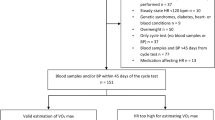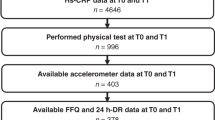Abstract
Purpose
To assess the role of adiposity in the relationship between physical fitness with cardiometabolic risk factors (CMRF), adipocytokines and inflammation in children.
Methods
This cross-sectional analysis, comprised 150 children (80 boys), aged 6–11 years, from a public school in the city of Porto Alegre/Brazil. Cardiorespiratory fitness (CRF), muscular fitness (MF), systolic and diastolic blood pressure and percentage of body fat were evaluated. Blood samples were collected to determine leptin, adiponectin and C-reactive protein (CRP) levels. CMRF was defined by the z score sum of high-density lipoprotein cholesterol, triglycerides, homeostasis model assessment of insulin resistance, total cholesterol, systolic and diastolic blood pressure.
Results
The association between CRF with CMRF (Indirect effect (IE) = − 0.0005; CI − 0.0010 to − 0.0002) and leptin (IE = − 0.0116; CI − 0.0185 to − 0.0062) is influenced by adiposity. The association between MF and CMRF (IE: − 0.0991; CI − 0.1971 to − 0.0217), leptin (IE: − 3.0251; CI − 4.2660 to − 2.0956) and CRP (IE: − 0.3590; CI − 0.6903 to − 0.0981) were also influenced by adiposity. Furthermore, the relationship between CRF and CMRF (β = 0.0001; p = 0.04) and leptin (β = 0.0008; p = 0.02), as well as between MF and CMRF (β = 0.01; p = 0.02) varied according to adiposity level.
Conclusion
Adiposity exert an essential role in the relationship of physical fitness with CMRF, adipocytokines and inflammation in children. This findings support the key role of adiposity, indicating that beyond physical fitness increases, intervention programs should also focus on decreasing adiposity in children.


Similar content being viewed by others
Abbreviations
- CRP:
-
C-reactive protein
- CRF:
-
Cardiorespiratory fitness
- MF:
-
Muscular fitness
- BMI:
-
Body mass index
- PROESP-Br:
-
Projeto Esporte Brasil
- HDL-C:
-
High-density lipoprotein cholesterol
- HOMA-IR:
-
Homeostasis model assessment of insulin resistance
References
Bugge A, El-Naaman B, Mcmurray RG, Froberg K, Andersen LB (2013) Tracking of clustered cardiovascular disease risk factors from childhood to adolescence. Pediatr Res 73(2):245–249
Saito I, Maruyama K, Eguchi E (2014) C-reactive protein and cardiovascular disease in East asians: a systematic review. Clin Med Insights Cardiol 8(3):35–42
Ouchi N, Parker JL, Lugus JJ, Walsh K (2011) Adipokines in inflammation and metabolic disease. Nat Rev Immunol 11(2):85–97
Todendi PF, Valim ARM, Reuter CP, Mello ED, Gaya AR, Burgos MS (2016) Metabolic risk in schoolchildren is associated with low levels of cardiorespiratory fitness, obesity, and parents ’ nutritional profile. J Pediatr 92(4):388–393
Väistö J, Haapala EA, Viitasalo A, Schnurr TM, Kilpeläinen TO, Karjalainen P et al (2019) Longitudinal associations of physical activity and sedentary time with cardiometabolic risk factors in children. Scand J Med Sci Sport 29(1):113–123
Ortega FB, Ruiz JR, Castillo MJ, Sjostrom M (2008) Physical fitness in childhood and adolescence: a powerful marker of health. Int J Obes 32(1):1–11
Ruiz JR, Cavero-Redondo I, Ortega FB, Welk GJ, Andersen LB, Martinez-Vizcaino V (2016) Cardiorespiratory fitness cut points to avoid cardiovascular disease risk in children and adolescents; what level of fitness should raise a red flag? A systematic review and meta-analysis. Br J Sports Med 50(23):1451–1458
Steene-Johannessen J, Kolle E, Andersen LB, Anderssen SA (2013) Adiposity, aerobic fitness, muscle fitness, and markers of inflammation in children. Med Sci Sport Exerc 45(4):714–721
Artero EG, Ruiz JR, Ortega FB, España-Romero V, Vicente-Rodríguez G, Molnar D et al (2011) Muscular and cardiorespiratory fitness are independently associated with metabolic risk in adolescents: the HELENA study. Pediatr Diabetes 12:704–712
Tomkinson GR, Lang JJ, Tremblay MS (2017) Temporal trends in the cardiorespiratory fitness of children and adolescents representing 19 high-income and upper middle-income countries between 1981 and 2014. Br J Sports Med 53(8):478–486
Pérez-bey A, Segura-jiménez V, Fernández-santos JR, Esteban-cornejo I, Gómez-martínez S, Veiga OL et al (2018) The influence of cardiorespiratory fitness on clustered cardiovascular disease risk factors and the mediator role of BMI in youth: the UP&DOWN study. J Pediatr 199:178–185
Pérez-Bey A, Segura-Jiménez V, Fernández-Santos J, Esteban-Cornejo I, Gómez-Martinez S, Veiga O et al (2019) The influence of cardiorespiratory fitness on clustered cardiovascular disease risk factors and the mediator role of BMI in youth: the UP&DOWN study. Pediatr Diabetes 20(1):32–40
Prentice AM, Jebb AS (2001) Beyond body mass index. Obes Rev 2(3):141–147
Artero EG, España-Romero V, Jiménez-Pavón D, Martinez-Gómez D, Warnberg J, Gómez-Martínez S et al (2014) Muscular fitness, fatness and inflammatory biomarkers in adolescents. Pediatr Obes 9(5):391–400
Agostinis-Sobrinho CA, Moreira C, Abreu S, Lopes L, Sardinha LB, Oliveira-Santos J et al (2017) Muscular fitness and metabolic and inflammatory biomarkers in adolescents: results from LabMed Physical Activity Study. Scand J Med Sci Sport 27(12):1873–1880
Gaya A, Lemos A, Gaya A, Teixeira D, Pinheiro E, Moreira R (2016) PROESP-Br Projeto Esporte Brasil Manual de testes e avaliação. Porto Alegre UFRGS 20:1–20
Bergmann GG, Bergmann GG, Castro AAMC, Lorenzi TD, Pinheiro ES, Moreira RB, Marques AC, Gaya A (2014) Use of the 6-minute walk/run test to predict peak oxygen uptake in adolescents para a predição do consumo de oxigênio de pico em adolescentes. Rev Bras Ativ Fis Saúde 19(1):64–73
Friedewald WT, Levy RI, Fredrickson DS (1972) Estimation of the concentration of low-density lipoprotein cholesterol in plasma, without use of the preparative ultracentrifuge. Clin Chem 18(6):499–502
Matthews DR, Hosker JP, Rudenski AS, Naylor BA, Treacher DF, Turner RC (1985) Homeostasis model assessment: insulin resistance and beta-cell function from fasting plasma glucose and insulin concentrations in man. Diabetol 28(7):412–419
Mirwald RL, Baxter-Jones ADG, Bailey DA, Beunen GP (2002) An assessment of maturity from anthropometric measurements. Med Sci Sports Exerc 34(4):689–694
Preacher KJ, Hayes AF (2008) Asymptotic and resampling strategies for assessing and comparing indirect effects in multiple mediator models. Behav Res Methods 40(3):879–891
Delgado-Alfonso A, Pérez-Bey A, Conde-Caveda J, Izquierdo-Gómez R, Esteban-Cornejo I, Gómez-Martínez S et al (2018) Independent and combined associations of physical fitness components with inflammatory biomarkers in children and adolescents. Pediatr Res 84:1–9
Baron RM, Kenny DA (1986) The moderator-mediator variable distinction in social psychological research: conceptual, strategic, and statistical considerations. J Pers Soc Psychol 51(6):1173–1118
Pérez-Bey A, Segura-Jiménez V, Fernández-Santos J, Esteban-Cornejo I, Gómez-Martínez S, Veiga O et al (2018) The role of adiposity in the association between muscular fitness and cardiovascular disease. J Pediatr 199:178–185
Garcia-Hermoso A, Agostinis-Sobrinho C, Mota J, Santos RM, Correa-Bautista JE, Ramírez-Vélez R (2017) Adiposity as a full mediator of the influence of cardiorespiratory fitness and inflammation in schoolchildren: the FUPRECOL Study. Nutr Metab Cardiovasc Dis 27(6):525–533
Purdom T, Kravitz L, Dokladny K, Mermier C (2018) Understanding the factors that effect maximal fat oxidation. J Int Soc Sports Nutr 15(1):1–10
Oliveira AG, Araujo TG, Carvalho BM, Guadagnini D, Rocha GZ, Bagarolli RA et al (2013) Acute exercise induces a phenotypic switch in adipose tissue macrophage polarization in diet-induced obese rats. Obesity 21(12):2545–2556
Bouchard C, Blair S, Haskell W (2012) Physical activity and health, 2nd ed. Human Kinetics, Champaigne
Smith JJ, Eather N, Morgan PJ, Plotnikoff RC, Faigenbaum AD, Lubans DR (2014) The health benefits of muscular fitness for children and adolescents: a systematic review and meta-analysis. Sport Med 44(9):1209–1223
Oktay AA, Lavie CJ, Kokkinos PF, Parto P, Pandey A, Ventura HO (2017) The interaction of cardiorespiratory fitness with obesity and the obesity paradox in cardiovascular disease. Prog Cardiovasc Dis 60(1):30–44
Ortega F, Ruiz JR, Labayen I, Lavie CJ, Blair SN (2018) The Fat but Fit paradox: what we know and don’t know about it. Br J Sports Med 20:20
Demmer DL, Beilin LJ, Hands B, Burrows S, Cox KL, Oddy WH et al (2017) Fatness and fitness with cardiometabolic risk factors in adolescents. J Clin Endocrinol Metab 102:4467–4476
Agostinis-sobrinho CA, Lacerda E, Moreira C (2017) Association between leptin, adiponectin, and leptin/adiponectin ratio with clustered metabolic risk factors in portuguese adolescents: the LabMed. Ann Nutr Metab 70(4):321–328
García-Hermoso A, Ramírez-Campillo R, Izquierdo M (2019) Is muscular fitness associated with future health benefits in children and adolescents? A systematic review and meta-analysis of longitudinal studies. Sport Med 20:1–16
Cohen DD, Gómez-Arbeláez D, Camacho PA, Pinzon S, Hormiga C, Trejos-Suarez J et al (2014) Low muscle strength is associated with metabolic risk factors in Colombian children: the ACFIES study. PLoS ONE 9(4):1–10
Ruiz JR, Castro-Piñero J, Artero EG, Ortega FB, Sjöström M, Suni J et al (2009) Predictive validity of health-related fitness in youth: a systematic review. Br J Sports Med 43(12):909–923
World Health Organization (2010) Global recommendations on physical activity for health. World Health Organization, Geneva
Piercy KL, Troiano RP, Ballard RM, Carlson SA, Fulton JE, Galuska DA et al (2018) The physical activity guidelines for Americans. JAMA 9762:1–9
Acknowledgements
This work was supported by the Brazilian National Council for Research and Technological Development under Grant 401969/2016-9/ Universal Announcement; Foundation for Science and Technology under Grant SFRH/BSAB/142983/2018 and UID/DTP/00617/2019; Coordination of Superior Level Staff Improvement.
Author information
Authors and Affiliations
Corresponding author
Ethics declarations
Conflict of interest
There are no potential conflict of interest.
Ethical approval
This study was conducted in accordance to the Helsinki Declaration for Human Studies of 1964, and approved by The Ethics and Research Committee of Federal University of Rio Grande do Sul (2014997).
Informed consent
Written informed assent and consent was obtained from the child and their parents/guardians respectively.
Additional information
Publisher's Note
Springer Nature remains neutral with regard to jurisdictional claims in published maps and institutional affiliations.
Rights and permissions
About this article
Cite this article
Brand, C., Gaya, A.C.A., Dias, A.F. et al. The role of adiposity in the relationship between physical fitness with cardiometabolic risk factors, adipocytokines and inflammation in children. Sport Sci Health 17, 127–136 (2021). https://doi.org/10.1007/s11332-020-00662-2
Received:
Accepted:
Published:
Issue Date:
DOI: https://doi.org/10.1007/s11332-020-00662-2




